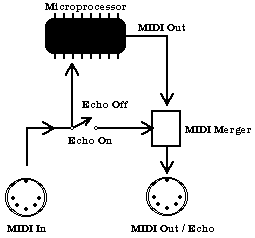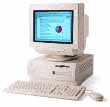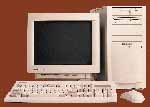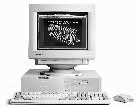
| There are many different types
of MIDI connections. The MIDI Out sends digital messages from one
MIDI device and into the MIDI In of another MIDI device. |
 |
| |
The MIDI Thru connector receives a copy of any digital message
coming into the MIDI In connection and sends a duplicate of this
information out of the MIDI Thru port into the MIDI In of
a third MIDI device. This allows the user to have more than two MIDI devices
connected as a studio. The MIDI Out port from the second or third
device in the diagram below would not work because it is sending MIDI information
from that particular synthesizer. The MIDI Thru port is receiving
the MIDI In information and passing it on to the next device.

When MIDI devices are linked together by a series of MIDI In and
MIDI Thru connections, it is referred to as a Daisy-Chain Network.
 |
Copies of MIDI In information may be sent to numerous devices by using MIDI
Thru Boxes, known as Star Networks. |
| A MIDI interface may only have two connections, a MIDI In and a MIDI
Out. This gives the user the ability to send information to a computer,
while the computer sends MIDI information out from a software program. Some
music software programs will have a MIDI Echo device that allows
a copy of the information to be merged with the information that is leaving
the computer from the MIDI Out ports. This enables the sequencing
software to simultaneously record the information that it is receiving at
the MIDI In port, while sending a copy of that information out of
the MIDI Out port along with previously recorded tracks of MIDI events. |
Example of a MIDI Echo / MIDI Merger
|
 |
 Return to MIDI Connections
Menu
Return to MIDI Connections
Menu
Connecting MIDI Studios
Now it is time to try connecting a few different MIDI studios. Listed
below are four different MIDI studios that are Java-enabled. Start with
Studio A, which has two MIDI keyboards, and then go to Studio B, which consists
of three MIDI keyboards. Studio C continues the concept of a daisy-chain,
but the studio is more sophisticated and contains a computer, interface,
keyboard, and three tone generators. Studio D is the last studio in the
series. It resembles Studio C but a MIDI star network is added to the system.
When you click on one of the studios listed below you will go to a separate
page that explains the program and uploads the Java applet. Wait for the
Java applet to load before preceding. The studio diagram picture will flash
until the applet is completely loaded. If the applet is not working properly,
press the reload button on your browser and try again.
 Return to MIDI
Connections Menu
Return to MIDI
Connections Menu
MIDI Interfaces
| The pictures below are MIDI interfaces for the Macintosh computer.
Interfaces may be purchased in many different styles and varying degrees
of complexity. |
 |
 |
 |
 |
|
pictures from Opcode and Apple Computer
 |
The pictures below are MIDI interfaces for Windows based computers.
Possible interfaces may be an external device or inserted into the computer
as an add-on card. |
 |
pictures from Music Quest Inc. and Dell Computer Corporation
 Return to MIDI
Connections Menu
Return to MIDI
Connections Menu
 |
|
MIDI Connections Java Enabled
|
|
|
|
|
|
|
|
|
|
|
|
|
|
|
|
|
|






![]() Return to MIDI
Connections Menu
Return to MIDI
Connections Menu



![]() Return to MIDI
Connections Menu
Return to MIDI
Connections Menu